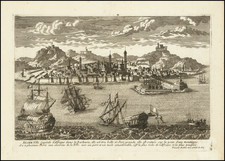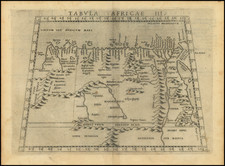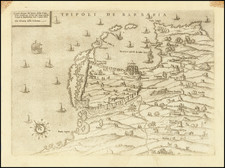French edition of the map illustrating George Francis Lyon's overland expedition from Tripoli to Fez, with Joseph Ritchie.
Visiting Paris in 1817, Ritchie had obtained the notice of Humboldt, and was recommended to the English government as qualified to undertake the exploration of the Nigritian Soudan by way of Tripoli and Fezzan.
Arriving at Malta in September, 1818, Ritchie made the acquaintance of Captain George Francis Lyon, who volunteered to accompany him in place of Captain Frederick Marryat, who was to have been his partner on the expedition, but had been prevented from joining. After long delays at Tripoli, and a short expedition to the Gharian mountains, Ritchie, Lyon, and their servant, Belford, transparently disguised as Moslems, left Tripoli for Murzuk, the capital of Fezzan, in March 1819.
The expedition was poorly planned by the sponsors in London, badly underfunded and misoutfitted. Ritchie died Murzuk, in the south of Fezzan in November 1819. Ritchie attempted a bit more of the journey, before returning to London.
Lyon's resulting account is an important travel book of the period, which was republished in French, the source of the present map.
Francis was a captain in the navy and traveller. He entered the navy in 1808, served in the Milford off Cadiz in 1810, followed Rear-admiral Keats to the Hibernia in the watch off Toulon, and was afterwards taken by Lord Exmouth into his flagship, the Caledonia, and appointed to the Berwick as lieutenant in July 1814. Lyon remaining in the Berwick and was at the siege of Gaeta in 1815. In December he was moved to the Albion as flag-lieutenant to Rear-admiral (afterwards Sir Charles) Penrose, and took part in the battle of Algiers on 27 Aug. 1816.
He was still in the Albion at Malta in September 1818, when Mr. Ritchie, secretary of the embassy at Paris, arrived there on his way to Tripoli to travel in Africa in the interests of the government. It had been arranged that Captain Frederick Marryat was to accompany Ritchie, but as Marryat was unable to do so Lyon volunteered to take his place, and in November joined Ritchie at Tripoli. He had already some knowledge of Arabic, and for the next four months studied assiduously, not only the language, but the religious and social forms of the Arabs.
The two left Tripoli towards the end of March 1819, and reached Murzuk after 39 days of travel. Here Lyon had a severe attack of dysentery, and he was barely convalescent when Ritchie was taken ill. The weather was extremely hot. On 20 June at 2 p.m. the temperature was registered as 133° F. in the shade; and the same extreme temperature was observed on other days in August and September. They were without funds, their stores were exhausted, and the sultan was greedy and suspicious.
On November 20, 1819, Ritchie died. Without resources, and still very feeble, Lyon pushed on towards the southern boundary of Fezzan, but he was forced to return, and reached Tripoli more dead than alive in March. Thence he sailed for Leghorn in May, and arrived in London in July 1820. The account of his journey was published as ‘A Narrative of Travels in North Africa in the years 1818, 1819, and 1820, accompanied by Geographical Notices of Soudan and of the Course of the Niger’ .









![[Governor Charles George Gordon's Route from Suakin to Khartoum 28 Feby to 13 March]](https://storage.googleapis.com/raremaps/img/small/99190.jpg)
![[ Morocco Coast -- Tangiers to El Beddouza ] Eijgentlijke vertooninge der westcuste van Barbarien, tusschen de Strate van Gibraltar ende de C: de Cantin, zampt aller Reeden Havenen ende Rivieren aldaer gelegen, en hoemen die bequamelijck sal besijlen](https://storage.googleapis.com/raremaps/img/small/62218.jpg)

![Egypt called in the Country Missir by Monsr. D'Anville of the Royal Academy of Belles Lettres, & of that of Siciences [sic] of Petersburg Secretary to H.S.H. the Duke of Orleans. MDCCLXV.](https://storage.googleapis.com/raremaps/img/small/49130.jpg)

